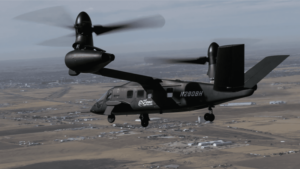NASHVILLE, Tenn.–The Army is targeting the third quarter of fiscal year 2024 for a Milestone B decision to move the Future Long Range Assault Aircraft (FLRAA) into a program of record, a senior official confirmed last week.
Maj. Gen. Robert Barrie, the Army’s program executive officer for aviation, said the service at that time would have a firm idea of the acquisition strategy and procurement objective for FLRAA, after having selected Bell’s [TXT] V-280 Valor tiltrotor design for the major modernization effort.

“We have initiated work with Bell on the Future Long Range Assault Aircraft. We’re very excited about this capability for the Army,” Barrie told reporters at the Army Aviation Mission Solutions Summit in Nashville. “We’re laser focused on execution. That’s what both the government team and Bell are executing today. It’s baselining the program, move out, approach Milestone B for the government, bring the program to record and continue with development”
Bell’s V-280 Valor was named the winner of the FLRAA competition on Dec. 5, beating out aJa Sikorsky [LMT] and Boeing [BA] team’s Defiant X coaxial rigid rotor helicopter offering for the program to find an eventual UH-60 Black Hawk helicopter replacement (Defense Daily, Dec. 5).
Maj. Gen. Water Rugen, director of the Army’s Future Vertical Lift Cross-Functional Team, told reporters the Army Requirements Oversight Council is set to meet this July to approve the capabilities development document for FLRAA, which will be followed by a Joint Requirements Oversight Council approval process later in 2023.
The Army’s initial FLRAA deal to Bell is worth up to $1.3 billion but could total $7 billion if all options are picked up.
Army officials have previously said the plan is to have Bell deliver the first physical prototypes for FLRAA in 2025, with continued digital design and work on the virtual prototype in the near-term as the program moves toward a Milestone B decision (Defense Daily, Dec. 6).
“From a milestone perspective…we’re looking at kicking off this program in a disciplined manner. From a programmatic standpoint, which is probably not super exciting to everyone but to us, our bread and butter is an integrated baseline review. [That’s] an understanding of, ‘Here’s the contract that was awarded. Here are exact, in infinite detail, milestones that are going to be understood at the earned value management level and here’s how they’re going to be tracked and here’s how cost account managers are going to report to program managers.’ So it’s things that we do inside program management,” Barrie said during the media briefing.
Gen. James McConville, the Army chief of staff, told reporters during the conference in Nashville last week he feels “very good” about FLRAA and specifically cited the speed and range offered by Bell’s V-280 tiltrotor design.
“The company is ready to go and they have invested in manufacturing. And, again, we’re going to have that discussion about the importance of performance, cost and schedule. That does matter,” McConville said. “I think there’s tremendous potential when you look at an aircraft that can go over 300 knots and what that’s going to be able to do. We’re just excited about having that capability, especially as we look out into the Indo-Pacific where the ranges are much longer.”
Sikorsky unsuccessfully protested the FLRAA award decision, with a Government Accountability Office report released in April noting the Army deemed its bid with Boeing “unacceptable” in the “architecture” subfactor for engineering and design (Defense Daily, April 14).